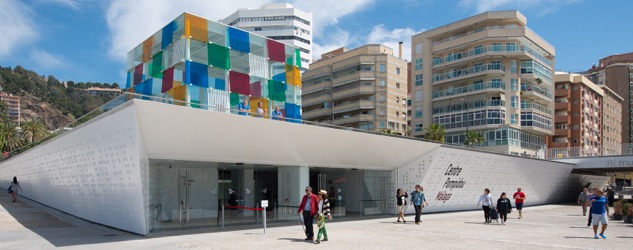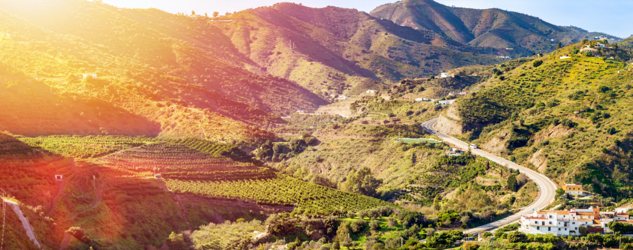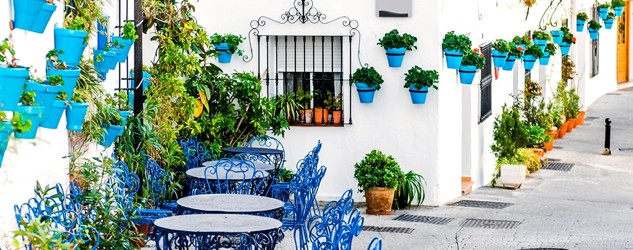There’s more to the Málaga region than just its vibrant capital: there’s the cuisine, villages and Caminito del Rey. Find out why you should come back to Málaga!
Málaga is Picasso, it’s the white villages, the beach bars of the Costa del Sol, the Easter celebrations and even, if that’s what you’re after, Antonio Banderas. Read on for 6 ways to get off the beaten track in and around Málaga!
Visit the Pompidou without leaving the country

The franchise museum is the future, and the biggest names are already putting pins in the map of contemporary culture with branches in different countries: the Louvre for one, or the Pompidou, which opened its first branch outside of Paris in Málaga in 2015.
Muelle Uno (pier one) is one of the city’s hottest hotspots and where the Pompidou’s first international centre is located. The 16 m-high coloured glass structure of the El Cubo building quickly becomes visible as you make your way along the pier, shining like some kind of cultural beacon. It’s quickly become one of the city’s landmarks and one of the museums not to be missed on a trip to Málaga.
Inside Málaga’s Pompidou Centre, a fascinating journey through 20th- and 21st-century art awaits the visitor, with outstanding works by Frida Kahlo, John Currin and Francis Bacon, to name but a few of the superstars of the art world contained within.
And yet more art
People come to Málaga for the modern art alone. And no wonder with the MAUS Málaga Arte Urbano Soho project and the Centro de Arte Contemporáneo like satellites orbiting the Pompidou Centre on the map. Both are located in the city’s artiest neighbourhood, Soho, which is the perfect place to get lost on a second visit to Málaga.
In this old fishing neighbourhood, family-run shops and pedestrianised streets coexist alongside different urban art initiatives. Just follow the route laid out by Street Art Málaga to see works by D'face and Obey in awe-inspiring XXL, as well as others including Faith47, Dal East, Manuel León, Pejac, Dadi Dreucol and Felipe Pantone.
The cherry on the cake is the Centro de Arte Contemporáneo de Málaga, a byword for art in Andalusia. Since it opened in 2003 in a renovated wholesale market, it’s become an exhibition space and somewhere to experience art, playing host to important names on the international scene.
A sustainable Caminito del Rey
In the ‘90s, the Caminito gained a reputation for being one of the most dangerous walks in the world, making it a magnet for thrill-seekers. So, it was only to be expected that its restoration in late March 2015 would make it one of Málaga’s don’t-miss attractions. People are increasingly keen to experience the vertiginous route, though these days with the appropriate safety measures.
Just over 65 km from the capital, the Caminito del Rey is one far and away of the best things you can do near Málaga. But if you’re thinking of factoring it into your next visit, be sure to plan ahead: mindful of the enormous pressure from so many visitors on the natural environment, authorities have limited access to 1100 people per day during different time slots. You can reserve via the official website but don’t leave it too late!
Wineries with chemistry (but 100% eco)

La Axarquía is one of those places close to Málaga that’s not to be missed and sure to be a big hit with wine tourists. Located in the easternmost part of the region, it stretches from the coast to the interior, and the interior is the place to be if you fancy a spot of wine tourism. Some of the best Andalusian wines and Spanish muscatels are made right here.
The landscape is covered in Alexandria grape vines that arrived with the Phoenicians centuries ago, although the Romé variety is also gaining ground. The town of Sedella is a good example of the appeal of wines made with this native variety of grape. And it’s here, on the green slopes of the Tejeda and Almijara ranges, that wine expert Lauren Rosillo decided to open her winery. Due to the steep slopes, these ancient vines are cultivated using traditional methods like animal-drawn ploughs, which may well be the secret to one of the best reds in the region.
You can visit the modern Sedella winery designed by architect Paco Varela to work in harmony with the Axarquía landscape, as you taste three different vintages of wine and enjoy the stunning views.
Benalauría and Júzcar versus depopulation
There’s a lot of talk these days about ‘empty Spain’ and the phenomena of depopulation, something Málaga is no stranger to, so it’s worth taking a drive south to get to know the area around Málaga better. Here, Benalauría and Júzcar await the visitor, two good examples of efforts to combat the abandonment of the interior.
The town of Júzcar sits in the Serranía de Ronda range. Its origins were something of a military secret guarded by Phillip V, but today the town lives from wine tourism. On the banks of the Genal river and surrounded by forests, this was the perfect place to construct the Real Fábrica de Hojalata de San Miguel (Royal Tinplate Factory) in 1728, the first blast furnace in Spain. In those days, tinplate was a key material in military industry as it was used for armour plating Spanish galleons.
However, the factory closed in 1786 not long after it opened. At the beginning of the 21st century, it was practically in ruins until it was turned into an organic-winemaking centre, a historical monument and some very special accommodation.
From the former tinplate factory, it’s just 33 km to Benalauría along the winding A369; it’s worth taking it slowly to enjoy the views of a string of villages perched atop the mountain range. One of these is Benalauría, another good example of how wine and tourism have given people a reason to stick around.
A route that’s foodie heaven

Renowned chef Dani García has given up his three Michelin stars and closed the doors of his Marbella restaurant. But that doesn’t mean you have to give up on the gastro experience when planning what to do in the Málaga region. There are seven Michelin stars here between six establishments, as well as loads of bars, taverns, eateries and restaurants where you can enjoy Málaga cuisine, all of which aren’t short on ideas and raw ingredients.
There are still six Michelin-starred establishments that are worth making the trip to Málaga for: José Carlos García’s restaurant next to the Pompidou Centre where the chef’s recommendations sing the praises of local produce; Kabuki Raw, a surprising Japanese concept in an Andalusian hacienda in Casares; and Sollo in Fuengirola where sustainability is key for Brazilian chef Diego Gallegos. That said, Marbella still boasts the most Michelin stars in the region, home to El Lago (one star), Skina (two stars) and Messina (one star).







